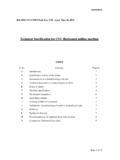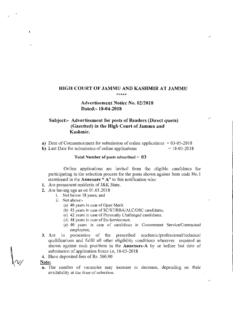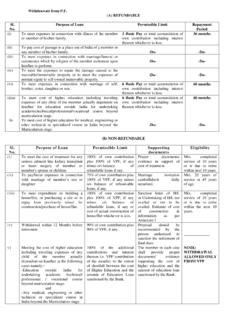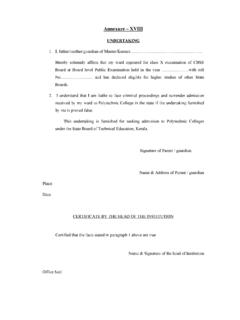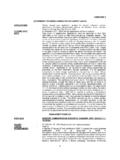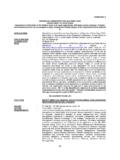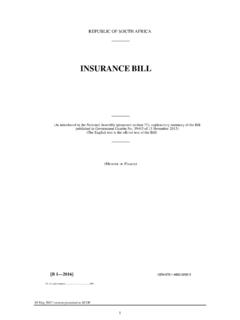Transcription of Explanatory memorandum to the division of revenue
1 1 W1 Explanatory memorandum to the division of revenue Background Section 214(1) of the Constitution requires that every year a division of revenue Act determine the equitable division of nationally raised revenue between national government, the nine provinces and 257 municipalities (278 municipalities prior to the 2016 local government elections). The tabled allocations are published with the new municipal demarcations even though the elections will be held later in the year. The division of revenue takes into account the powers and functions assigned to each sphere of government. The process fosters transparency and is at the heart of constitutional cooperative governance.
2 The Intergovernmental Fiscal Relations Act (1997) prescribes the process for determining the equitable sharing and allocation of nationally raised revenue . Sections 9 and 10(4) of the act set out the consultation process to be followed with the Financial and Fiscal Commission (FFC), including considering the commission s recommendations regarding the division of revenue . This Explanatory memorandum to the 2016 division of revenue Bill fulfils the requirement set out in section 10(5) of the Intergovernmental Fiscal Relations Act that the bill be accompanied by an explanation of how it takes account of the matters listed in sections 214(2)(a) to (j) of the Constitution, government s response to the FFC s recommendations, and any assumptions and formulas used in arriving at the respective divisions among provinces and municipalities.
3 This Explanatory memorandum has six sections: Part 1 lists the factors that inform the division of resources between national, provincial and local government. Part 2 describes the 2016 division of revenue . Part 3 sets out how the FFC s recommendations on the 2016 division of revenue have been taken into account. 2016 BUDGET REVIEW 2 Part 4 explains the formula and criteria for the division of the provincial equitable share and conditional grants among provinces. Part 5 sets out the formula and criteria for the division of the local government equitable share and conditional grants among municipalities. Part 6 summarises issues that will form part of subsequent reviews of provincial and local government fiscal frameworks.
4 The division of revenue Bill and its underlying allocations are the result of extensive consultation between national, provincial and local government. The Budget Council deliberated on the matters discussed in this memorandum at several meetings during the year. The approach to local government allocations was discussed with organised local government at technical meetings with the South African Local Government Association (SALGA), culminating in meetings of the Budget Forum (the Budget Council and SALGA). An extended Cabinet meeting involving ministers, provincial premiers and the SALGA chairperson was held in October 2015.
5 The division of revenue , and the government priorities that underpin it, was agreed for the next three years. Part 1: Constitutional considerations The annual division of revenue Act is enacted after factors in sections 214(2)(a) to (j) of the Constitution are taken into account. These include national interest, debt provision, the needs of national government, flexibility in responding to emergencies, resource allocation for basic services and developmental needs, the fiscal capacity and efficiency of provincial and local government, the reduction of economic disparities, and the promotion of stability and predictability. The constitutional principles taken into account in deciding on the division of revenue are briefly noted below.
6 National interest and the division of resources The national interest is encapsulated by governance goals that benefit the nation as a whole. The National Development Plan, endorsed by Cabinet in November 2012, sets out a long-term vision for the country s development. This is complemented by the strategic integrated projects overseen by the Presidential Infrastructure Coordinating Council and the 14 priority outcomes adopted by Cabinet in 2014 for the 2014 2019 medium-term strategic framework. In the 2015 Medium Term Budget Policy Statement, the Minister of Finance outlined how the resources available to government over the 2016 medium-term expenditure framework (MTEF) would be allocated to help achieve these goals.
7 Chapter 4 of the 2015 Medium Term Budget Policy Statement and Chapters 5 and 6 of the 2016 Budget Review discuss how funds have been allocated across government based on these priorities. The frameworks for each conditional grant allocated as part of the division of revenue also note how the grant is linked to the 14 priority outcomes. Provision for debt costs The resources shared between national, provincial and local government include proceeds from national government borrowing used to fund public spending. National government provides for the resulting debt costs to protect the country s integrity and credit reputation.
8 A more detailed discussion can be found in Chapter 7 of the 2016 Budget Review. National government s needs and interests The Constitution assigns exclusive and concurrent powers and functions to each sphere of government. National government is exclusively responsible for functions that serve the national interest and are best centralised. National and provincial government have concurrent responsibility for a range of functions. Provincial and local government receive equitable shares and conditional grants to enable them to provide basic services and perform their functions. Functions may shift between spheres of government to better meet its needs.
9 The division of revenue responds to this by modifying the funding arrangements. annexure W1: Explanatory memorandum TO THE division OF revenue 3 Changes continue to be made to various national transfers to provincial and local government to improve their efficiency, effectiveness and alignment with national strategic objectives. Provincial and local government basic services Provinces and municipalities are assigned service delivery functions such as education, health, social development, housing, roads, provision of electricity and water, and municipal infrastructure. They have significant autonomy to allocate resources to meet basic needs and respond to provincial and local priorities, while giving effect to national objectives.
10 The division of revenue provides equitable shares to provinces and local government, together with conditional grants for basic service delivery. Strong growth in allocations to provincial and local government reflects government s emphasis on priority services such as health, education and basic services, as well as the rising costs of these services due to higher wages, and bulk electricity and water costs. Transfers to local government have grown significantly in recent years, providing municipalities with greater resources to deliver basic services. This is in addition to local government s substantial revenue -raising powers.











